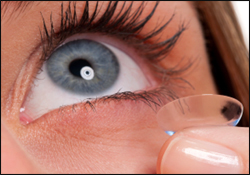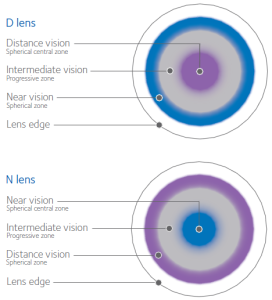 The technology of contact lenses has come a long, long way in the past 10 years, solving most of the problems that people associate with these medical devices.
The technology of contact lenses has come a long, long way in the past 10 years, solving most of the problems that people associate with these medical devices.
“Contacts lenses irritate my eyes”… Done!… more natural and wettable materials to improve comfort!
“I can’t wear contacts because of my astigmatism”… yes you can with new toric technology!
“But I’m over 40 and need to wear reading glasses with my contact lenses”… well, let me tell you about Bifocal Contact Lenses…
Bifocals contact lenses aren’t necessarily new to the contact lens market. The first bifocal contact lenses came out about 20 years ago; however, it was so darn bad that it turned off a lot of patients (and doctors) to the potential of these designs. As manufacturing techniques and technology have improved, this class of contacts has reaped the rewards. Bifocal contact lenses these days are stunning, giving patients clear distance and reading vision with an 85-90% success rate.
How do Bifocal Contact Lenses Work
The key to bifocal contact lenses is in the design. These lenses are bifocals in the name only and work nothing like a pair of bifocal glasses. Bifocal glasses have different zones within each lens with very different prescriptions for clear vision from distance to near. You simply need to direct your eyes through that section of the lens for clear vision at that whatever distance you want to see. Since a contact lens is so small and always sits at the same place on the cornea, it is not feasibility for the lens to move around enough to look through different areas.
 Instead, if you look at these lenses under a microscope they have concentric rings just like the rings on a dart board. Each ring of a bifocal contact lens is designed to focus for a different place: distance, intermediate or computer, and reading (see right). All the vision from all distances is focused by the contact onto the retina in the back of the eye and the retina sends that information to the brain.
Instead, if you look at these lenses under a microscope they have concentric rings just like the rings on a dart board. Each ring of a bifocal contact lens is designed to focus for a different place: distance, intermediate or computer, and reading (see right). All the vision from all distances is focused by the contact onto the retina in the back of the eye and the retina sends that information to the brain.
What the brain receives is a garbled, distorted mess, but the supercomputer sitting between our ears is able to filter out the distances that it’s not interested in. This results in you being able to read a menu one moment and then check the score of a ball game on a television the next. This process sounds quite convoluted but it actually works surprisingly well!
Additionally, there are multiple parameters we can change and adjust to fine tune the vision through these contacts based on how they work for the patient in real life situations.
Keys to Success with Bifocal Contact Lenses
There is no panacea, or cure all, for the “Curse of the 40’s” but Bifocal Contact Lenses are a large step in that direction. The keys to success with these lenses are realistic expectations and patience. Since the brain has never used lenses like this before, it takes 2-4 weeks of daily wear for the brain to understand how these lenses ‘work.’ During that time it is common to notice some distortion and blurring but most of that goes away over time.
If you are new to Bifocal Contact Lenses there has never been a better time to try out this technology.
Schedule an appointment with you eye care specialist today!
– Nick Wolf, OD


